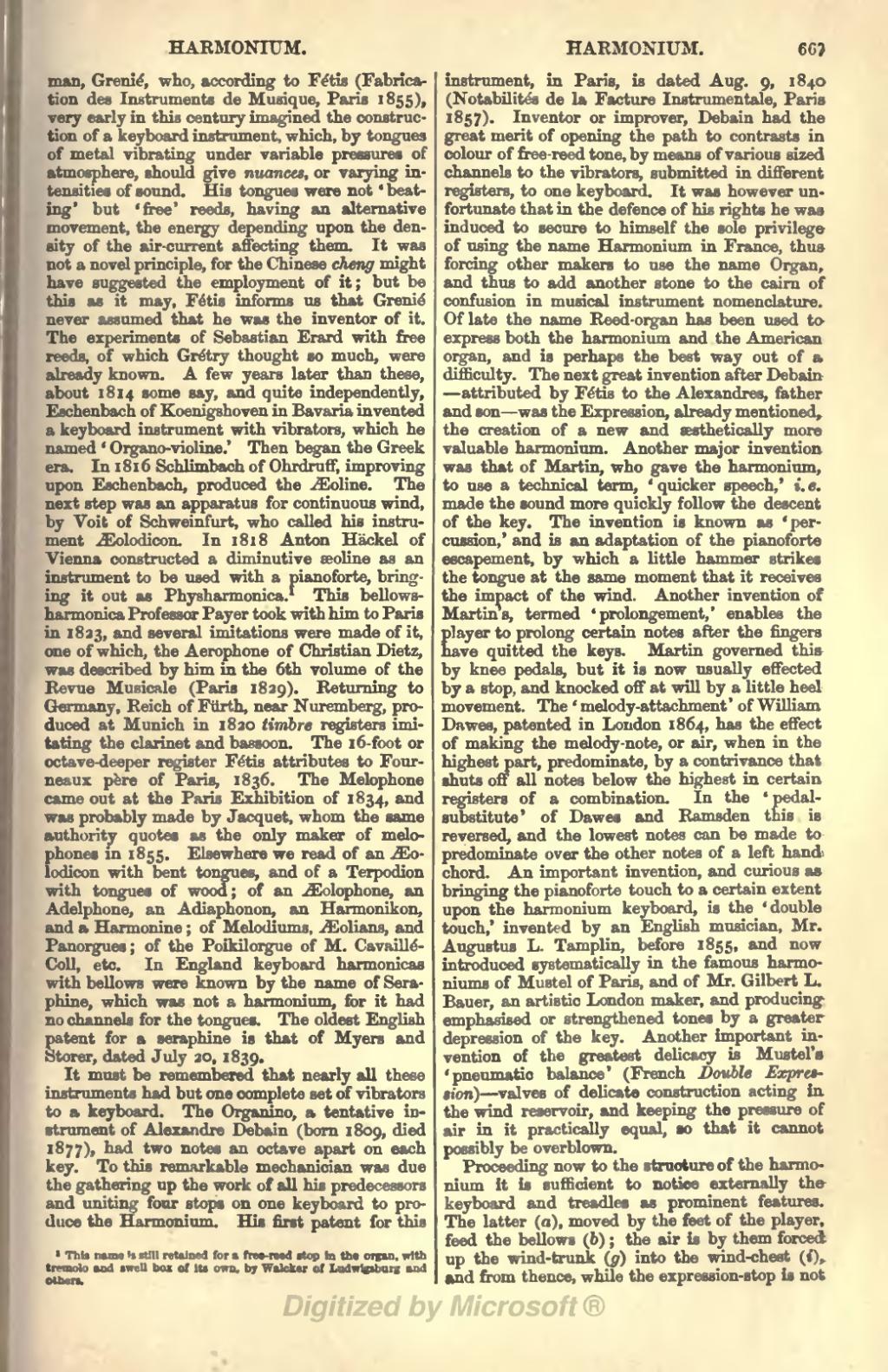man, Grenié, who, according to Fétis (Fabrication des Instruments de Musique, Paris 1855), very early in this century imagined the construction of a keyboard instrument, which, by tongues of metal vibrating under variable pressures of atmosphere, should give nuances, or varying intensities of sound. His tongues were not 'beating' but 'free' reeds, having an alternative movement, the energy depending upon the density of the air-current affecting them. It was not a novel principle, for the Chinese cheng might have suggested the employment of it; but be this as it may, Fétis informs us that Grenie never assumed that he was the inventor of it. The experiments of Sebastian Erard with free reeds, of which Grétry thought so much, were already known. A few years later than these, about 1814 some say, and quite independently, Eschenbach of Koenigshoven in Bavaria invented a keyboard instrument with vibrators, which he named 'Organo-violine.' Then began the Greek era. In 1816 Schlimbach of Ohrdruff, improving upon Eschenbach, produced the Æoline. The next step was an apparatus for continuous wind, by Voit of Schweinfurt, who called his instrument Æolodicon. In 1818 Anton Häckel of Vienna constructed a diminutive æoline as an instrument to be used with a pianoforte, bringing it out as Physharmonica.[1] This bellows-harmonica Professor Payer took with him to Paris in 1823, and several imitations were made of it, one of which, the Aerophone of Christian Dietz, was described by him in the 6th volume of the Revue Musicale (Paris 1829). Returning to Germany, Reich of Fürth, near Nuremberg, produced at Munich in 1820 timbre registers imitating the clarinet and bassoon. The 16-foot or octave-deeper register Fétis attributes to Fourneaux père of Paris, 1836. The Melophone came out at the Paris Exhibition of 1834, and was probably made by Jacquet, whom the same authority quotes as the only maker of melophones in 1855. Elsewhere we read of an Æolodicon with bent tongues, and of a Terpodion with tongues of wood; of an Æolophone, an Adelphone, an Adiaphonon, an Harmonikon, and a Harmonine; of Melodiums, Æolians, and Panorgues; of the Poikilorgue of M. Cavaillé-Coll, etc. In England keyboard harmonicas with bellows were known by the name of Seraphine, which was not a harmonium, for it had no channels for the tongues. The oldest English patent for a seraphine is that of Myers and Storer, dated July 20, 1839.
It must be remembered that nearly all these instruments had but one complete set of vibrators to a keyboard. The Organino, a tentative instrument of Alexandra Debain (born 1809, died 1877), had two notes an octave apart on each key. To this remarkable mechanician was due the gathering up the work of all his predecessors and uniting four stops on one keyboard to produce the Harmonium. His first patent for this instrument, in Paris, is dated Aug. 9, 1840 (Notabilités de la Facture Instrumental, Paris 1857). Inventor or improver, Debain had the great merit of opening the path to contrasts in colour of free-reed tone, by means of various sized channels to the vibrators, submitted in different registers, to one keyboard. It was however unfortunate that in the defence of his rights he was induced to secure to himself the sole privilege of using the name Harmonium in France, thus forcing other makers to use the name Organ, and thus to add another stone to the cairn of confusion in musical instrument nomenclature. Of late the name Reed-organ has been used toexpress both the harmonium and the American organ, and is perhaps the best way out of a difficulty. The next great invention after Debain—attributed by Fétis to the Alexandres, father and son—was the Expression, already mentioned, the creation of a new and æsthetically more valuable harmonium. Another major invention was that of Martin, who gave the harmonium, to use a technical term, 'quicker speech,' i.e. made the sound more quickly follow the descent of the key. The invention is known as 'percussion,' and is an adaptation of the pianoforte escapement, by which a little hammer strikes the tongue at the same moment that it receives the impact of the wind. Another invention of Martins, termed 'prolongement,' enables the player to prolong certain notes after the fingers have quitted the keys. Martin governed this by knee pedals, but it is now usually effected by a stop, and knocked off at will by a little heel movement. The 'melody-attachment' of William Dawes, patented in London 1864, has the effect of making the melody-note, or air, when in the highest part, predominate, by a contrivance that shuts off all notes below the highest in certain registers of a combination. In the 'pedal-substitute' of Dawes and Ramsden this is reversed, and the lowest notes can be made to predominate over the other notes of a left hand chord. An important invention, and curious as bringing the pianoforte touch to a certain extent upon the harmonium keyboard, is the 'double touch,' invented by an English musician, Mr. Augustus L. Tamplin, before 1855, and now introduced systematically in the famous harmoniums of Mustel of Paris, and of Mr. Gilbert L. Bauer, an artistic London maker, and producing emphasised or strengthened tones by a greater depression of the key. Another important invention of the greatest delicacy is Mustel's 'pneumatic balance' (French Double Expression)—valves of delicate construction acting in the wind reservoir, and keeping the pressure of air in it practically equal, so that it cannot possibly be overblown.
Proceeding now to the structure of the harmonium it is sufficient to notice externally the keyboard and treadles as prominent features. The latter (a), moved by the feet of the player, feed the bellows (b); the air is by them forced up the wind-trunk (g) into the wind-chest (i), and from thence, while the expression-stop is not
- ↑ This name it still retained for a free-reed stop in the organ, with tremolo and swell box of its own, by Walcker of Ludwigsberg and others.
